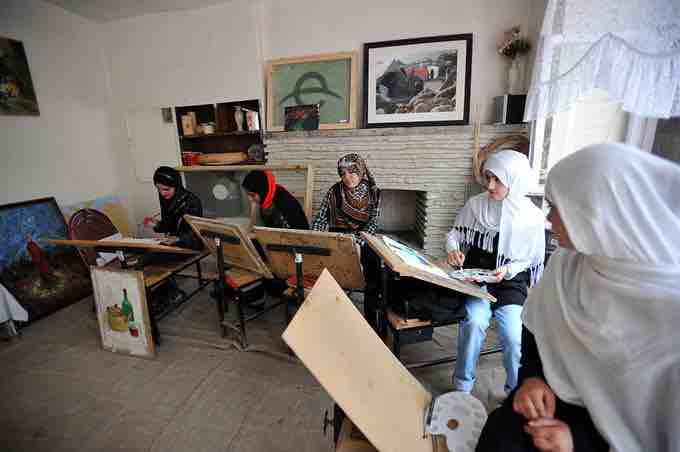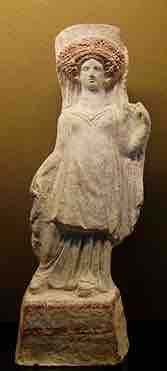In pre-Islamic Arabia, women's status varied widely according to the laws and cultural norms of the tribes in which they lived. In the prosperous southern region of the Arabian Peninsula, for example, the religious edicts of Christianity and Judaism held sway among the Sabians and Himyarites. In other places, such as the city of Mecca, and in the nomadic Bedouin tribes, tribal law determined women's rights. Therefore, there was no single definition of the roles played and rights held by women prior to the advent of Islam.
Depiction of the costumes of women in the 4th-6th centuries
Under the customary tribal law existing in Arabia before the rise of Islam, as a general rule women had virtually no legal status; fathers sold their daughters into marriage for a price, the husband could terminate the union at will, and women had little or no property or succession rights.
Tribal Law
Under the customary tribal law existing in Arabia at the advent of Islam, as a general rule women had virtually no legal status. The tribe acted as the main functional unit of Arabian society and was composed of people with connections to a common relative. These tribes were patriarchal and inheritance was passed through the male lines; women could not inherit property. The tribal leader enforced the tribe's spoken rules, which generally limited the rights of the women. Women were often considered property to be inherited or seized in a tribal conflict.
There were also patterns of homicidal abuse of women and girls, including instances of killing female infants if they were considered a liability. The Quran mentions that the Arabs in Jahiliyyah (the period of ignorance or pre-Islamic period) used to bury their daughters alive. The motives were twofold: the fear that an increase in female offspring would result in economic burden, and the fear of the humiliation frequently caused when girls were captured by a hostile tribe and subsequently preferring their captors to their parents and brothers.
Women in Islam and the Hijab
After the rise of Islam, the Quran (the word of God) and the Hadith (the traditions of the prophet Muhammad) developed into Sharia, or Islamic religious law. Sharia dictates that women should cover themselves with a veil. Women who follow these traditions feel it wearing the hijab is their claim to respectability and piety. One of the relevant passages from the Quran translates as "O Prophet! Tell thy wives and daughters, and the believing women, that they should cast their outer garments over their persons, that are most convenient, that they should be known and not molested. And Allah is Oft-Forgiving, Most Merciful" (Quran Surat Al-Ahzab 33:59). These areas of the body are known as "awrah" (parts of the body that should be covered) and are referred to in both the Quran and the Hadith. "Hijab" can also be used to refer to the seclusion of women from men in the public sphere.

Modern-day female art students in Afghanistan
In many modern Islamic countries, Sharia combines politics and religion. For example, in Saudi Arabia it is mandatory for women to wear the hijab, while in Afghanistan it is very common but not legally required by the state.
The practice of women covering themselves with veils was also known during pre-Islamic times. In the Byzantine Empire and pre-Islamic Persia, a veil was a symbol of respect worn by the elite and upper-class women.

Standing woman holding her veil. Terracotta figurine, c. 400–375 BC
Veils were present in the Byzantine Empire and pre-Islamic Persia, and veil wearing is now a basic principle of the Islamic faith.
Marriage
In pre-Islamic Arabian culture, women had little control over their marriages and were rarely allowed to divorce their husbands. Marriages usually consisted of an agreement between a man and his future wife's family, and occurred either within the tribe or between two families of different tribes. As part of the agreement, the man's family might offer property such as camels or horses in exchange for the woman. Upon marriage, the woman would leave her family and reside permanently in the tribe of her husband. Marriage by capture, or "Ba'al," was also a common pre-Islamic practice.
Under Islam, polygyny (the marriage of multiple women to one man) is allowed, but not widespread. In some Islamic countries, such as Iran, a woman's husband may enter into temporary marriages in addition to permanent marriage. Islam forbids Muslim women from marrying non-Muslims.
Family Structure
One of the most important roles for women in pre-Islamic tribes was to produce children, especially male offspring. A woman's male children could inherit property and increased the wealth of the tribe. While men often tended the herds of livestock and guarded the tribe, women played integral roles within tribal society. Women cooked meals, milked animals, washed clothes, prepared butter and cheese, spun wool, and wove fabric for tents.
Upper-Class Women
While the general population of women in pre-Islamic Arabia did not enjoy the luxury of many rights, many women of upper-class status did. They married into comfortable homes and were sometimes able to own property or even inherit from relatives.